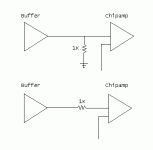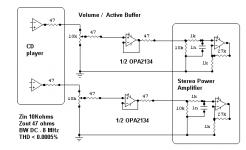Does anyone have thoughts on a SIMPLE input buffer, like one that involves an op amp, an input wire, a feedback wire and an output wire? (Well, not that simple, but you get the idea, I don't want a 10 component buffer). I posted this in the bottom of a thread below, but the more I think about it the more it belongs in its own thread.
the OPA627 was suggested, and the spec sheet looks like it can be used with no external parts, but that doesn't seem right in a practical application, but ok from a theoretical standpoint.
As a side note, I have read a few commercial products that rave about using Burr Brown amps, which I found out were TI products. Anyone use these as buffers, and if so does anyone have a suggestion to which chip?
Thanks,
Adam
the OPA627 was suggested, and the spec sheet looks like it can be used with no external parts, but that doesn't seem right in a practical application, but ok from a theoretical standpoint.
As a side note, I have read a few commercial products that rave about using Burr Brown amps, which I found out were TI products. Anyone use these as buffers, and if so does anyone have a suggestion to which chip?
Thanks,
Adam
buf634 ? nice buffer but it somewhat degrades sound quality when used outside of an opamp;s feedback loop (imho).
/matti
/matti
The OPA627 would work fine. So would the OPA132, OPA134, OPA604, or their dual versions (OPA2132, -2134, -2604), or any other high quality opamp that is stable at unity gain. All that you need to do is tie the output pin to the -input pin, and put the input signal onto the +input pin. This creates a "voltage follower" configuration, where the output voltage is equal to the input voltage. Now you can set the input impedance as high as you want (within reason; note that higher impedance will mean higher noise) and drive the chipamp with a low input impedance. Just make sure that the opamp you choose can drive the impedance you choose for your chipamp's input impedance (most will drive 600 ohms or higher). Make sure to decouple your opamps with a small capacitor connected very close to the opamp.
macboy said:The OPA627 would work fine. So would the OPA132, OPA134, OPA604, or their dual versions (OPA2132, -2134, -2604), or any other high quality opamp that is stable at unity gain. All that you need to do is tie the output pin to the -input pin, and put the input signal onto the +input pin. This creates a "voltage follower" configuration, where the output voltage is equal to the input voltage.
Just a question that nobody seems to have raised yet when using an inverting gainclone: what about the absolute phase the music was originally recorded at? With an IGC we are listening to inverted version of it.
There has been lots of discussions on whether keeping original phase is important or not for the music experience.
So why not trying a basic inverter here? We would have a buffer and also get phase back to normal.
Has anyone tried that? Pros and cons in that path?
One con I can think of is how would I use a BUF634 inside the feedback ring on a basic inverter.
Carlos
carlmart said:
Just a question that nobody seems to have raised yet when using an inverting gainclone: what about the absolute phase the music was originally recorded at? With an IGC we are listening to inverted version of it.
There has been lots of discussions on whether keeping original phase is important or not for the music experience.
So why not trying a basic inverter here? We would have a buffer and also get phase back to normal.
Has anyone tried that? Pros and cons in that path?
One con I can think of is how would I use a BUF634 inside the feedback ring on a basic inverter.
Carlos
To solve the problem with the IGC you just have to connect the two speakers in revers (- of the speeker to the output of the amp and the + of the speaker to GND).
/Greg
wouldn't an emitter follower be a simple and effective solution here? I posted a simple (one transistor, 6 resistor and 2 caps) pre-amp circuit on the solid state forum and it can be easily set up as a follower and it works unmodified with a lot of transistors / rail voltages.
to me, that would beat out an IC buffer.
to me, that would beat out an IC buffer.
This is all thinking right now, but somewhere down the road, it'll be in front of a parallel lm3886 or a bridge/parallel config with the same chips. How are the buffers that National specs for the BPA200, the LF411?
Thanks,
Adam
Thanks,
Adam
carlmart said:
Just a question that nobody seems to have raised yet when using an inverting gainclone: what about the absolute phase the music was originally recorded at? With an IGC we are listening to inverted version of it.
There has been lots of discussions on whether keeping original phase is important or not for the music experience.
So why not trying a basic inverter here? We would have a buffer and also get phase back to normal.
Has anyone tried that? Pros and cons in that path?
One con I can think of is how would I use a BUF634 inside the feedback ring on a basic inverter.
Carlos
Carlos,
I have checked invereted polarity vs. correct polarity many times. There is a considerable audible difference. For example - bass is lazy and worse defined, when inverting the phase.
I would always recommend to keep the correct phase.
Pavel
Hybrid fourdoor said:In regards to buffer to amp, which resistor method would be best here?
One is for inverting config, the other for non-inverting 😉
GregGC said:I hope you don't want to connect the buffer in front of a NIGC.
/Greg
Hi!
Why not?
Regards
Tor M
carlmart said:Just a question that nobody seems to have raised yet when using an inverting gainclone: what about the absolute phase the music was originally recorded at? With an IGC we are listening to inverted version of it.
There has been lots of discussions on whether keeping original phase is important or not for the music experience.
Absolute phase does make a difference (if your system can resolve it), but it is really totally imaterial if an amp, preamp or whatever is inverting or non-inverting. The reason for this is that the source material will be inconsistent as to phase... it can vary album to album, or track-to-track... and then there are cuts where no attention was paid, and channels are mixed together that have different abs phase... the only solution is to have an abs phase switch and select by ear.
And further flipping speaker polarities is also not a sure thing... most speakers are marked red for positive if a battery causes the woofer to move out when the positive terminal is connected to it, but there are some out there that are marked opposite of that.
dave
Any schematics of a simple buffer using OPA opamps ?
Hi,
Any schematics of a simple buffer using OPA opamps ? I am having some of them with me waiting for an implementation.
Best regards,
Bins.
Hi,
Any schematics of a simple buffer using OPA opamps ? I am having some of them with me waiting for an implementation.
Best regards,
Bins.
The OPA627 would work fine. So would the OPA132, OPA134, OPA604, or their dual versions (OPA2132, -2134, -2604), or any other high quality opamp that is stable at unity gain. All that you need to do is tie the output pin to the -input pin, and put the input signal onto the +input pin. This creates a "voltage follower" configuration, where the output voltage is equal to the input voltage. Now you can set the input impedance as high as you want (within reason; note that higher impedance will mean higher noise) and drive the chipamp with a low input impedance. Just make sure that the opamp you choose can drive the impedance you choose for your chipamp's input impedance (most will drive 600 ohms or higher). Make sure to decouple your opamps with a small capacitor connected very close to the opamp.
Hi,
Any schematics of a simple buffer using OPA opamps ? I am having some of them with me waiting for an implementation.
Best regards,
Bins.
I snatched this picture from a thread here a few years back; don't remember which one or who posted it.......
Attachments
Instead of the wire from Pin 6 to Pin 2 i would recommend a resistor that is similar to the source impedance at normal volume for lowest common mode distortion. Something around 1 to 5Kohm. The OPA2134 is very prone to common mode distortion. In fact a OPamp buffer is a worst case condition for common mode distortion. It makes the distortion in the treble go up. Fortunately the low value 10kOhm pot helps a bit.
- Status
- Not open for further replies.
- Home
- Amplifiers
- Chip Amps
- Simple Input Buffer

